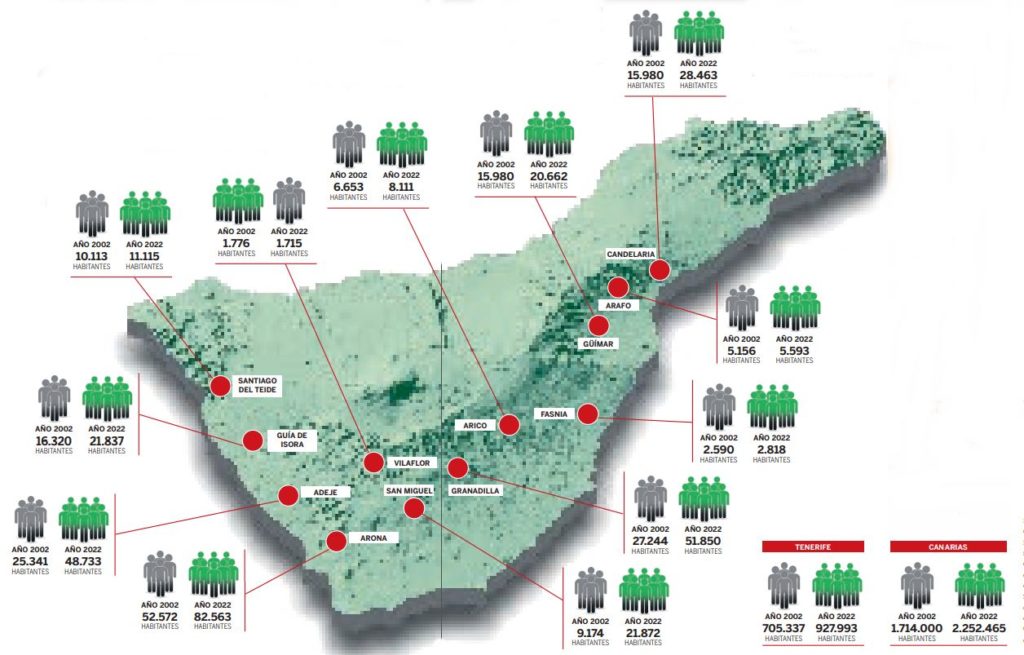The south of Tenerife, from Candelaria to Santiago del Teide, has experienced a considerable increase in population so far this century, almost doubling the number of residents according to the census and a little less if we stick to INE data in 2021. Using only the National Institute of Statistics, in the twelve municipalities the increase since 2002 has been almost 120,000 people (from 188,899 to 306,332). All this without counting those who are not registered or, of course, the almost 15,000 visitors on average daily that the tourist municipalities receive.
An overpopulation that has begun to be debated among our politicians, especially when it comes to demanding more services and better infrastructures (housing, roads, hospitals, car parks…). “When the ship is overweight it sinks and this can happen to the Island,” warns the mayor of San Miguel de Abona, Arturo González, whose municipality has gone from 9,174 inhabitants to 21,827 in twenty years. “One thing is to diagnose and another question to put the antidote.

The Parliament has to debate overpopulation seriously”, he pointed out, while recalling that “in Tenerife there are not enough water resources to keep up with this rate of growth, the price of water is going to go through the roof”, he remarked. Mari Brito, mayor of Candelaria and president of Fecam, on the other hand, emphasizes the depopulation of rural municipalities, and for this reason “we try to promote economic development and employment projects, and the creation of public services to settle the population and prevent their displacement to large cities or other neighboring municipalities”.
This growth in the South, which has been contained in the last two years due to the pandemic, has been possible due, above all, to migration, with special emphasis on the Italian colony, already the largest, and the returnees from Venezuela. , many of whom do not appear in the census of foreigners, as they have dual nationality, as occurs with Argentines, Colombians, Cubans or Uruguayans, also very numerous in the south of the island. Thanks to migration, the Canary Islands maintained in 2021 their population growth with 0.36%, reaching the figure of 2,252,465 inhabitants.
And it is that the vegetative growth continues in free fall. Not only because of the increase in deaths during the pandemic, but also because of the prolonged drop in the birth rate since the 2010 crisis. At that time, 20,117 boys and girls were born in the Canary Islands for the 12,703 that saw the light of day. last year. If we compare births and deaths, the balance is negative, since there were 17,718 deaths, 4,475 more than births. Population growth, therefore, must be sought in migration. In 2021, the new migrants registered in the Canary Islands were 12,702, a figure almost identical to births.
tourist towns
In the last half century, the South has not stopped growing. And it has continued to be El Dorado for thousands of workers who find their daily food in hotels, construction or the service sector. Many left their families in the North or in La Gomera to move to Granadilla, Arona, Adeje or Guía de Isora, although there are also those who come from other towns in the South or the metropolitan area, but the vast majority are foreigners.
The lack of training of the native population, especially in languages, has allowed the massive arrival of foreign labor, both European and South American, while Asian citizens (Chinese and Indians) take over a large part of the trade, together with the multinational chains , passing the South from being the great unknown of Tenerife to becoming the economic engine of the Island.
Within this population growth, it is worth highlighting the one carried out in the last twenty years by Arona and Adeje, the main tourist receptors of the Island, with an enormous population density (11,114 and 462 inhabitants, respectively, per square kilometer). Thus, sticking to the official figures as of January 1, 2021, Adeje already has 48,773 inhabitants, while in Arona they exceed 82,500, although the City Council affirms that the population is close to 100,000 inhabitants taking into account the census and not the INE.
Two other tourist municipalities, Guía de Isora and Santiago del Teide, have grown more moderately, while Granadilla de Abona and San Miguel de Abona are also leading the growth, especially in the last ten years, basically because they have become dormitories thanks to tourist work, not finding housing accommodation near their jobs.
San Isidro, in Granadilla, with more than 20,000 residents, is the main example. Outside the deep south, the growth of Candelaria also stands out, which went from 15,000 inhabitants in 2002 to almost 30,000 at the end of last year, with a population density of 573 inhabitants per square kilometer. Its proximity to the metropolitan area and its good connections have helped it to grow in an orderly manner, although it does not do so anymore because the construction of private developments and public housing suffered a great halt with the 2008 crisis. Today renting or buying in Candelaria is a task impossible.
Only one town in the south has lost inhabitants in the last twenty years, Vilaflor de Chasna, the least populated of the 31 Tenerife municipalities with 1,715 inhabitants.
Jose Julian Mena
José Julián Mena, mayor of Arona, the most populous municipality in the South, recalls, when asked about curbing the population, that “both migration and border policies are not among the municipal powers. What is certain is that the South has experienced an exponential increase in its population in recent decades, while maintaining almost the same level of services. We have entered the 21st century with infrastructures and services of the 20th century. We see this not only on the roads and in mobility as a whole, but also in the demand that we have been making since 2015 for the completion of a hospital with the complete portfolio of services for the South Region, new educational centers and health centers” .













